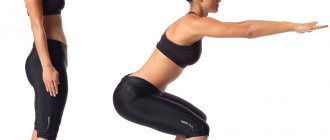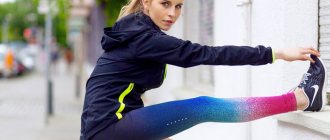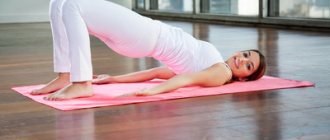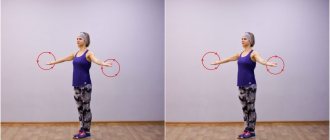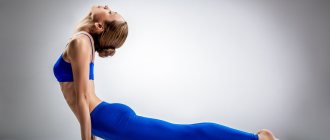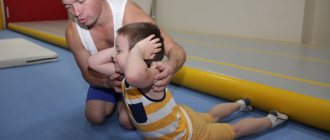Anyone at least once in their life has experienced problems waking up in the morning. With the wrong lifestyle, waking up becomes more and more difficult every year, and the consequences of lack of sleep continue throughout the day. To get rid of the state of weakness, increase your level of vigor and start a new day with joy, we offer you a special morning yoga complex.
- A set of yoga exercises for the morning - Comfortable pose (Sukhasana)
- Video: How to do Sukhasana correctly
- Neck warm-up
- Tilts the head back and forth
- Head tilts to the sides
- Head rotation
- Lateral bends from Sukhasana
- Warm-up for chest and back
- Chair Pose (Utkasana)
- Video: How to perform Utkatasana correctly
- Warrior Pose I (Virabhadrasana I)
- Video: Nuances of performing Warrior I pose
- Twisted Side Angle Pose (Parivritta Parsvakonasana)
- Video: How to do Twisted Side Angle pose correctly
- Downward Facing Dog Pose (Adho Mukha Svanasana)
- Video: Downward Facing Dog for Beginners
- Upward Facing Dog Pose (Urdhva Mukha Svanasana)
- Video: Making Upward Facing Dog correctly
- Hare Pose (Shashankasana)
- Dead Body Pose (Savasana)
- Video: Morning Shavasana
A set of yoga exercises for the morning - Comfortable pose (Sukhasana)
Let's start our morning with Sukhasana. The very name of this asana translates as “comfortable pose.” “In the world” this position is referred to as “sitting cross-legged.” Many people, even those who do not practice yoga, intuitively sit in this position because it is really simple and comfortable. However, Sukhasana has its own nuances that must be observed to achieve maximum effectiveness.
- We sit down on a hard surface, straighten our back, stretch our legs forward.
- Bend your right leg, pulling its heel towards the inside of your left thigh.
- Having bent the left leg, we place its shin on the right shin, and put the foot between the thigh and calf of the right leg, under the right knee.
- We spread our knees wide and relax our feet.
- We place our hands on our knees, and our palms can look both up and down, and our elbows should be exactly under our shoulders.
- We reach up behind the top of the head, straightening our back.
- You can close your eyes to concentrate on the sensations.
To keep your back straight, slightly arch your lower back, straighten your chest, but do not raise your shoulders. Also make sure that the head remains in line with the entire body.
This simple pose will improve the performance of the joints of the lower extremities, strengthen the back, normalize blood circulation and the functioning of the gastrointestinal tract.
The best pose to prepare for practice
Now, to tune in to the activity, direct your attention to your breathing. Try to breathe evenly through both your stomach and chest. Breathe a little deeper and slower than usual. Now try to move your attention throughout your body - from the top of your head to your toes and back. This will help you establish contact with your body and tune in to practice.
Video: How to do Sukhasana correctly
Having tuned in properly and without leaving a comfortable position, we begin training individual parts of the body.
Yoga in bed with Katerina Buida morning complex “Energy Charge”
Most women plan their workouts in the evening, when they already come home from work and feel tired. Often such activities are exhausting, but do not produce results. If you train yourself to get up half an hour earlier than usual and do simple exercises from your favorite routine, you can significantly increase your level of vital energy, improve your physical well-being and your mood.
It’s not for nothing that all doctors and scientists talk about the benefits of morning exercises - the faster your body gets ready for work, the more productive your whole working day will be!
Neck warm-up
While remaining in Sukhasana, let's begin to warm up the neck muscles.
Tilts the head back and forth
The first point is head tilts, which are performed as follows:
- While in Sukhasana, straighten the spine and smoothly lower the head forward, exhaling.
- Exhaling calmly, we return to the neutral position.
- Repeat the above steps 8 times.
Bends are performed at an average pace
Throughout the entire exercise, the shoulders, torso, upper and lower limbs should be motionless, only the head moves.
Head tilts to the sides
Next, we tilt our heads left and right.
- Sitting in Sukhasana, we relax the shoulder muscles.
- As you exhale, calmly tilt your head to the right, stretch the neck muscles, but do not allow it to bend. Pull your top ear toward the ceiling, not your bottom ear toward your shoulder.
- While inhaling, we return to the original position.
- Smoothly tilt your head to the left.
- We do the described movements 4-5 times in each direction.
Great exercise to strengthen your neck
Let's give our muscles a little rest and proceed to the next exercise.
Head rotation
You can move on to the final part of the neck warm-up - head rotation - only after the previous exercises, when it is already sufficiently prepared.
- We sit in Sukhasana with a straight back.
- As you exhale, lower your head, bringing your chin closer to your neck, and begin to outline a circle. When the head goes up, we inhale, when down, we exhale.
- Slowly make 3-5 circles in one direction.
- We stop, raise our head, slightly stretching upward, and again tilt our head towards the chest.
- We outline 3-5 circles in the opposite direction.
Remember that the amplitude should be small; we focus on stretching behind the crown, not allowing the head to freely tilt back or to the sides.
Don't do this exercise at the beginning of your warm-up.
Be sure to control your condition while performing rotations. If you begin to feel unwell or in pain, stop any head movements and calmly take deep breaths.
Lateral bends from Sukhasana
Let's do some stretching and relax the sides of our torso.
- Remaining in Sukhasana, we stretch our right arm up and tense our abdominal muscles.
- Leaning on your left arm, as you exhale, slowly bend to the left until you feel tension and stretching of the oblique muscles. We linger in this position, trying to bend a little lower with each exhalation, and with each inhalation, stretch our hand a little further to the side.
- As you inhale, take the starting asana.
- Raise your left hand and tilt to the right, leaning on your right hand.
- We bend over 3-4 times in each direction.
Side bends will help you find a beautiful waist
All movements are performed evenly and slowly.
The morning yoga complex begins with defining the goal; this will take no more than two minutes.
- Close your eyes, for a minute just monitor the state of your body and your thoughts. Try to answer yourself the question of what you need most today. Perhaps you want to calm down and stop being nervous, or relax your body, or become more aware?
- Listen to your feelings to choose the purpose of your practice. This goal will give you an understanding of what your day will be like today.
The next component of practice is breathing exercises. The breathing practice will take only 3 minutes. To do this, take a comfortable sitting position. Start breathing through your nose - inhale and exhale in three counts. If necessary, you can increase the frequency or length of inhalation and exhalation. Breathe in a way that makes you most comfortable. If you need to relieve tension and calm down, then inhale twice as long as the exhalation, for example, inhale for two counts, exhale for four.
Warm-up for chest and back
The final invigorating exercise performed while sitting in Sukhasana is rounding the chest and back.
- We sit in the initial asana with a straight back, clasping our knees with our hands.
- As you inhale, we bend in the lumbar region and expand the chest, pushing it up.
- We remain in this position for several seconds.
As you exhale, we move the body back, rounding the back and slightly tilting the head, pulling the navel towards the spine.
We repeat the exercise about 10 times, trying to evenly stretch the back and front surfaces of the body. We always complete the exercise with a round back, moving from this position to neutral as we inhale.
Try to bend as much as possible
Rounding the back and chest perfectly warms up the muscles of the entire body, stretching and massaging them.
Chair Pose (Utkasana)
Having warmed up thoroughly while sitting, we move on to asanas from a standing position. One of the simple, but very useful poses is the Chair pose, also known as Utkatasana (see video).
- We stand straight, legs together, heels pressed firmly to the floor.
- Bend your knees so that your knees do not go beyond the line of your toes and look forward.
- We tilt the pelvis back, do not bend the back in the lower back, pull in the stomach, twist the tailbone towards ourselves.
- We stretch our arms in front of us or up, holding them parallel to each other.
- We move our shoulders back and down, we try to straighten our chest and pull it up.
- We remain in the asana for 30–45 seconds.
The higher your arms are raised, the more your chest opens.
Chair pose is very beneficial, it strengthens the pelvis, hips, knees and ankles. Corrects flat feet, posture, normalizes the functioning of the cardiovascular system, diaphragm and abdominal organs, trains balance, and tones the body.
Video: How to perform Utkatasana correctly
Warrior Pose I (Virabhadrasana I)
One of the most famous poses of modern yoga is the warrior pose, which has several variations. To wake up in the morning, he suggests doing the first of them.
- We stand up straight, spread our legs wide (the width between the feet is 100–120 centimeters), and lower our arms along the body.
- Bend your right leg at a right angle and turn your foot 90 degrees, and turn your left foot to the right, about 45 degrees.
- With an inhalation, we stretch our arms above us, palms facing each other, the left leg is fully straightened, the heel does not leave the floor, and the gaze is directed in front of us.
- We don’t move the body forward, pull it straight up, lower the shoulder blades and shoulders, open the chest.
- Slightly tilt our head back and direct our gaze into the space between our palms. If you have neck problems or are experiencing pain, you can simply look forward.
- We remain in the asana for 30 seconds.
- Inhaling, we connect our legs and take the starting position.
- We repeat the algorithm of actions on the other leg.
Warrior Pose I is a simple but very useful asana.
Virabhadrasana I strengthens the muscles and joints of the lower extremities, trains the abdominal muscles, strengthens the mental connection with the body, develops coordination, develops confidence and courage.
Video: Nuances of performing Warrior I pose
Complete your morning yoga routine with 2 minutes of meditation
Lie on your back and relax. Place your arms at a 45-degree angle from your body, palms facing up, shoulders down and relaxed. You can close your eyes and concentrate on the sensations in your body - from your feet to the top of your head. Remember your chosen goal and let thoughts flow calmly through your head, just watch them, breathe calmly and naturally. After completing the meditation, take a deep breath and carefully rise from the mat.
If you repeat this simple complex daily, you are guaranteed an influx of energy and productivity in the morning, as well as calmness and awareness throughout the day.
Twisted Side Angle Pose (Parivritta Parsvakonasana)
This twist may seem difficult at first, the main thing is to act carefully and stop at a point that is comfortable for you.
- We stand in Tadasana (straighten our back, lower our arms to our sides, bring our legs together).
- We take a deep breath, spread the lower limbs to a width of 100–120 centimeters.
- The placement of the feet is the same as in the previous asana: we turn the right foot 90 degrees, and turn the left foot diagonally inward. Bend the right knee at a right angle.
- As you inhale, stretch your arms up, and as you exhale, join your palms and curl toward your right thigh. We cling to the right thigh with our left elbow.
- If you have good flexibility, try to twist so that your palms are at the center of your chest. But do not use excessive force, otherwise you risk damaging the vertebrae. There shouldn't be any pain.
- After 30 seconds in this pose, carefully straighten up.
- Return to the starting position and repeat the movements on the other side.
Simplified version of the asana
The asana allows you to lose weight and pump up your thighs and abs; it also helps improve digestion.
Video: How to do Twisted Side Angle pose correctly
Yoga for 15 minutes in the morning, which is easy to do at home
A morning yoga routine for beginners should include only simple asanas, which take 15 minutes to complete. More technically challenging poses require more energy, concentration and coordination. Even if the benefits are great, their implementation should be postponed to the evening.
Before you start training, you need to take time to get in the mood and even out your breathing.
Setting an Intention – 2 minutes
You need to take a comfortable position, close your eyes, relax and for 2 minutes monitor the sensations in your body and the thoughts that flash through your head. We must try to answer the question of what should be done in the coming hours. If tension is felt in the body, it is necessary to gradually relax each part of it, starting from the tips of the fingers and ending with the feet. You should tune in to peace and tranquility. The purpose of morning practice is to track your sensations and evoke those that are necessary.
Even breathing practice – 3 minutes
You need to sit on the floor or on the mat in the position that will be most comfortable. You should breathe through your nose while counting to yourself. Inhale for 3 counts, exhale for 3 counts. If necessary, the length can be increased to 5-6, or, conversely, reduced. It is important that there is no discomfort in the body. You need to focus on your own feelings.
If you exhale twice as long as your inhalation, it will have a calming effect. For example, he inhales for 2 counts, and exhales for 4 counts. After you have managed to even out your breathing and relax your mind and body, you can begin to perform asanas.
Main part of the lesson: yoga poses, yoga training 15 minutes
An important condition that should be adhered to when performing yoga instead of exercise is the following: when taking poses, you need to remember about even, deep breathing. Thanks to this approach, it will be possible to achieve awareness, establish a strong connection between the mind and body, and achieve balance, which is important for the body.
Each pose should take 2-2.5 minutes.
Child's Pose
Child's pose opens morning asanas. In order to perform it, you need to sit on your heels, spread your legs and tilt your torso forward so that you can lower your forehead in front of you. Both arms are extended forward, the chest should lie on the knees. While the pose is held, the breath should be directed into the torso, while as you exhale you should try to relax as much as possible in order to be able to fold even more.
Balasana, as Child's Pose is called, helps eliminate tension in the shoulders, chest, neck and spine. With proper breathing, internal organs are massaged. The asana has a beneficial effect on the nervous system, calms the brain, and improves its blood supply. It has a good effect on the lower body: it stretches the muscles and tendons of the legs, reduces the fat layer on the thighs.
Bridge pose, pelvic tilt
Morning yoga for beginners should include doing bridge pose. It helps relieve tension in the back, tightness, promotes rejuvenation and healing of the body.
To perform it, you need to lie on your back, placing a thick blanket under your neck and shoulders. You need to bend your knees and move your feet as close to your buttocks as possible. As you inhale, the tailbone is lifted off the floor and raised up, while the buttocks are not compressed, but strengthened. Hips and feet should be in line. The arms extended along the body are clasped and held from under the pelvis.
The buttocks should be raised so that the thighs can be parallel to the floor surface. The knees are directly above the heels. At this time, the shoulder blades lie on the floor so that there is space between them. The chin is slightly raised from the chest.
Cat-cow pose
Used in yoga to invigorate and increase energy. Asana allows you to relieve tension on several levels at once. Movements become more relaxed, the back is straight. By regularly performing this pose, you can strengthen your abdominal muscles, make your spine more flexible, and relieve pain in the back. Develops exercise and flexibility.
To perform it, you need to get on all fours so that your palms lie directly under your shoulders and your knees are close to your hip joints. The fingers on your hands need to be spread apart: the middle fingers should be pointed forward, and the rest to the side. You cannot lean on your toes; the heels should be spread out to the sides.
As you inhale, try to bend your back down as deeply as possible, and stretch the back of your head up, directing your head back so that it is directed toward the ceiling. As you exhale, the head is pulled to the chest, and the back is arched upward so that an arch is formed. While performing the exercise, you need to make sure that your arms remain straight in a vertical position. Do up to 8-10 repetitions, staying in each position for some time.
Head down dog pose
This asana can be included in your warm-up every day. The pose helps strengthen the torso and back, eliminates tension in the chest, tightens the leg muscles, and keeps the body in good shape.
To perform the asana, you need to stand on all fours so that your knees are under your hips and your palms are under your shoulders. After inhaling, they begin to lift their hips up while straightening their knees. The body should form an inverted Latin letter V. The fingers should be kept apart. The palms are pressed to the surface of the floor, the neck is straightened and they try to see the navel. Stay in this position for 1-2 minutes, after which they bend their knees, lowering them to their original position.
Standing Forward Bend Pose
Yoga in the morning should definitely include a bending asana. The simplest exercise is the front bend from a standing position. To do this, you need to stand up straight, straighten your shoulders, put your feet next to each other. The arms are straightened and held above oneself. Then, while inhaling, they begin to bend forward, trying to lean their forehead against their shins as close as possible. You need to clasp your legs with your arms so as to lower your upper body further. It is important not to bend your knee joints.
Tree pose
To awaken, it is good to use tree pose. While in this asana, you need to try to imagine yourself as a tree, through the roots (legs) of which the energy of the earth enters the trunk (torso).
The asana is performed in a standing position. The feet are placed parallel to each other, the legs are kept together. After inhaling, they begin to raise their straight arms up along the sides along the body, after which they connect them above their head with their palms facing each other.
Your biceps should touch your ears. The whole body should be directed upward, but without rising on the toes. Then one leg is bent at the knee and the foot is placed on the inner side of the thigh, in its upper part. Stay in this position for 1 minute, after which you return to the starting position and repeat the exercise for the other leg.
Inhalation and exhalation when performing an asana should be the same in duration.
Warrior Pose
To perform warrior pose, you need to stand up straight with your legs together and your feet pressed together. The chest and shoulders need to be relaxed. The gaze is directed forward. Then exhale and take a big step back. The distance should be 100-120 cm. Feet pressed to the floor; the front one is directed forward, the back one is at an angle of 45° inward. The front knee should be bent at a right angle, distributing the weight evenly on both legs.
The arms are extended to the sides, the back of the head is directed upward, the neck is slightly strained, and the face looks forward. Breathing through the nose should be smooth and conscious. Stay in the pose for 1 minute, then repeat it for the other leg.
Two Minute Meditation
Yoga for energy for 15 minutes should be accompanied by mandatory meditation. It can take no longer than 2 minutes. You need to lie on your back and relax all parts of your body. Place your arms at an angle of 45° from your body, palms facing up. Then you need to close your eyes and feel your whole body, every cell of it. Attention should be moved from the tips of the toes upward, ending at the back of the head.
It is necessary to monitor your thoughts: without getting carried away by any of them, you must remain an outside observer. Breathing should be smooth and calm. You need to end the meditation with a deep breath. They rise slowly, helping themselves with their hands.
Morning yoga can be performed with relaxing music.
Downward Facing Dog Pose (Adho Mukha Svanasana)
The famous Downward Facing Dog pose, also known as Adho Mukha Svanasana, is perfect for those who want to perk up in the morning. It activates many muscles, strengthens the legs, promotes digestion, and ensures blood flow to the head.
- We get on all fours, the bases of our palms should be under our shoulders, and our knees should be under our pelvic bones.
- Exhale and lift your pelvis up, straightening your legs.
- We try to fully straighten our knees, pulling our heels towards the floor.
- We evenly distribute the body weight on the upper and lower limbs, do not raise the head, and the neck is relaxed.
- We try to keep our back straight, we expand the area of the shoulder blades, directing the shoulder blades towards the front of the body, and not moving them.
- We are in the pose for about 30–60 seconds.
- As we inhale, we return to all fours.
Arms and legs must be straight
This asana will greatly improve the flexibility of your body. The pose also relieves headaches, insomnia and bad mood.
Video: Downward Facing Dog for Beginners
What are the benefits of morning yoga?
Experts point out that doing yoga in the morning provides the body with the required level of stress. The benefits of exercise will be as follows:
- The body is filled with energy. Throughout the day, the person will be more active.
- Yoga helps you wake up faster, promotes clear organization of your daily routine, and develops discipline.
- Simple poses help relax the body.
- Metabolic processes are activated.
- Thanks to breathing exercises, the body is saturated with oxygen.
- The mind becomes clear and sharp.
Morning yoga for weight loss has a greater effect than a workout done in the evening, even if more exercises are performed during it.
Experienced instructors note that in the morning a person’s energy is purer, so classes bring more positive emotions and give a charge of positive energy for the whole day.
Upward Facing Dog Pose (Urdhva Mukha Svanasana)
This pose can be considered a more powerful version of another well-known yoga backbend - Cobra pose. Urdhva Mukha Svanasana is performed as follows:
- We lie down on a hard surface face down, place our palms under our shoulders, spread our fingers to the sides and tense.
- Resting your palms on the floor and inhaling, we evenly raise your head and body, lower your shoulders a little and move them back.
- We direct our chest forward, bend our back in the lumbar region.
- The hips and pelvis are torn off the floor, the support is only on the palms and the soles of the feet.
- You can keep your head straight or tilt it back slightly, but without bending your neck.
- We do 5-6 breathing cycles, remaining in the asana for 30 to 60 seconds.
- As you exhale, smoothly return to the original position.
It is important to keep your hips above the surface without straining your buttocks.
Upward Facing Dog Pose is an effective way to combat discomfort in the back area. It trains the muscles of the upper body, stimulates the performance of the lungs and heart, and normalizes the functioning of blood vessels and organs of the abdominal cavity and pelvis. The asana also pumps up the buttocks and abs and gives a boost of energy.
Video: Making Upward Facing Dog correctly
Hare Pose (Shashankasana)
Shashankasana is perfect for those who have just started practicing yoga. The Hare pose does not require special sports training, but, nevertheless, it perfectly relaxes the body, acting as an energy boost.
- We sit down with our legs bent under us, our back straight. Big toes together, knees slightly to the sides.
- As we inhale, we point our arms up, leaving our shoulders down.
- As you exhale, lower your body and arms, maintaining extension. We place our palms on the floor, stretch our stomach and lower ribs towards the floor, trying to place them between our thighs. The buttocks do not come off the heels.
- Relax and stretch for one or several minutes.
- As you inhale, gently bring your palms to your hips and take your original position.
Asana relieves fatigue and tones muscles
The Hare pose calms the nervous system, stimulates emotional uplift and mental activity, relieves irritability and headaches. Regular practice of Shashankasana improves posture and mobility of the spine.
Morning complex for slimness and beauty
Thus, “Morning complex for slimness and beauty” is a short workout in the spirit of yoga. If you like to sweetly stretch and stretch the muscles that have become stiff during sleep, this morning complex with Katerina Buida is perfect for you. Slow, competent, stretching - what could be better to get a body that has not yet woken up to work? This complex is well suited for beginners, as it does not contain complex asanas and does not require perfect stretching.
Another similar program offered by Katerina Buida is the “Gentle Sunrise” morning complex. It activates all metabolic processes, triggers energy production and fills you with a feeling of success that does not disappear throughout the day.
Dead Body Pose (Savasana)
This is an asana that completes any yogic practice, including morning ones. Corpse pose will allow you to relax physically and mentally as much as possible.
- Turn off electronic devices and make sure that people in your household will not disturb you.
- The room should be warm. You can cover yourself with a blanket or a blanket in advance, even if you are now very warmed up by exercise, since the metabolism in a relaxed body slows down and it begins to freeze faster.
- We lie with our backs on the floor, stretch our upper limbs in different directions with our palms up, and place our legs hip-width apart or slightly wider.
- We close our eyes; you can additionally use a blindfold.
- We focus on breathing, which should remain smooth and calm.
- Mentally we begin to relax all parts of our body.
- We direct attention to the feet, legs, knees, hips, buttocks, stomach, arms, ribs, chest, back, neck, facial muscles, and the entire surface of the head.
- We relax mentally, try not to fixate on any thoughts that arise, just let them go.
- Having finished relaxing, we gradually return to the real world, slowly emerging from Shavasana. To do this, you can gently move your feet and hands, turn on a comfortable side and sit down smoothly.
It is advisable to remain in the Dead Body Pose for at least 5–10 minutes.
At the same time the most relaxing and invigorating asana
While performing the asana, try to relax as much as possible, but not fall asleep.

